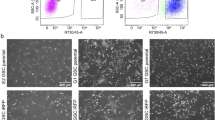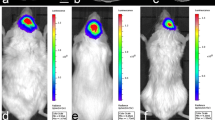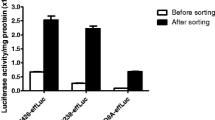Abstract
Introduction
Medulloblastoma (MB) is one of the most common malignant brain tumors in children. It is a radiosensitive tumor. At 5 years after radical surgical excision and craniospinal axis irradiation, the tumor-free survival rate is from 50 to 70% [Halperin EC, Constine LS, Tarbell NJ, Kun LE. Pediatric radiation oncology (2005)].
Case report
In this study, we established xenotransplanted human MB (hMB) cells — isochromosome 17q — in a severe combined immunodeficiency (SCID) mouse model. We further transduced green fluorescent protein (GFP) into hMB cells to evaluate these hMB cells grafted in SCID mice.
Results
The result of an ex vivo GFP imaging system showed that a small lesion of the third-week-hMB-transplanted graft presented “green” signals with a clear tumor margin before any tumor-related symptoms were noted. We also demonstrated that the tumor progression could be monitored by GFP imaging for up to 12 weeks post-transplantation.
Conclusions
This novel approach of GFP imaging assessment provides more accurate information of tumor status for experimental brain tumor studies. Because MB is sensitive to radiation and also response to chemotherapy, this SCID mouse model will be helpful for preclinical studies in the future.




Similar content being viewed by others
References
Halperin EC, Constine LS, Tarbell NJ, Kun LE (2005) Pediatric radiation oncology. Lippincott Williams & Wilkins, Philadelphia, pp 89–107
McNeil DE, Cote TR, Clegg L, Rorke LB (2002) Incidence and trends in pediatric malignancies medulloblastoma/primitive neuroectodermal tumor: a SEER update. Med Pediatr Oncol 39:190–194
Zeltzer PM, Boyett JM, Finlay JL, Albright AL, Rorke LB, Milstein JM (1999) Metastasis stage, adjunvant treatment, and residual tumor are prognostic factors for medulloblastoma in children. J Clin Oncol 17:832–845
Rutkowski S, Bode U, Deinlein F, Ottensmeier H, Warmuth-Metz M (2005) Treatment of early childhood medulloblastoma by postoperative chemotherapy alone. N Engl J Med 352:978–986
Rice JM (2004) Causation of nervous system tumors in children: insights from traditional and genetically engineered animal models. Toxicol Appl Pharm 199:175–191
Dyer MA (2004) Mouse models of childhood cancer of the nervous system. J Clin Pathol 57:561–576
Sterling-Levis K, White L (2003) The role of xenografting in pediatric brain tumor research with specific emphasis on medulloblastoma/primitive neuroectodermal tumors of childhood. In Vivo 17:329–342
White L, Sterling-Levis K, Kees UR (2001) Medulloblastoma/primitive neuroectodermal tumor studied as a Matrigel enhanced subcutaneous xenograft model. J Clin Neurosci 8:151–156
Huang P, Allam A, Taghian A, Freeman J, Duffy M (1995) Growth and metastatic behavior of five human glioblastomas compared with nine other histological types of human tumor xenografts in SCID mice. J Neurosurg 83:308–315
Kao CL, Chiou SH, Chen YJ, Singh S, Lin HT (2005) Increased expression of osteopontin gene in atypical teratoid/rhabdoid tumor of the central nervous system. Mod Pathol 18:769–778
Chen YJ, Chen PJ, Lee MC, Yeh SH, Hsu MT, Lin CH (2002) Chromosomal analysis of hepatic adenoma and focal nodular hyperplasia by comparative genomic hybridization. Genes Chromosomes Cancer 35:138–143
Peng H, Chen ST, Wergedal JE, Polo JM, Yee JK (2001) Development of an MFG-based retroviral vector system for secretion of high levels of functionally active human BMP4. Mol Ther 4:95–104
Vachon P, Girard C, Theoret Y (2004) Effects of basic fibroblastic growth factor on the growth of human medulloblastoma xenograft. J Neurooncol 67:139–146
Ho DM, Hsu CY, Chiang H (2002) Histopathologic grading of medulloblastomas. Cancer 95:2577–2578
Tong CY, Hui AB, Yin XL, Pang JC, Zhu XL (2004) Detection of oncogene amplifications in medulloblastomas by comparative genomic hybridization and array-CGH. J Neurosurg 100:187–193
Saunders DE, Hayward RD, Phipps KP, Chong WK, Wade AM (2003) Surveillance neuroimaging of intracranial medulloblastoma in children: how effective, how often, and for how long? J Neurosurg 99:280–286
Wetmore C, Eberhart DE, Curran T (2001) Loss of p53 but not accelerate medulloblastoma in mice heterozygous for patched. Cancer Res 61:513–516
Pang JC, Chang Q, Chung YF, Teo JG, Poon WS (2005) Epigenetic inactivation of DLC-1 in supratentorial primitive neuroectodermal tumor. Hum Pathol 36:36–43
Di Marcotullio L, Ferretti E, De Smaele E, Argenti B, Mincione C (2004) RENKCTD11 is a suppressor of hedgehog signaling and is deleted in human medulloblastoma. Proc Natl Acad Sci USA 101:10833–10838
Pinte S, Stankovic-Valentin N, Deltour S, Rood BR, Guerardel C, Leprince D (2004) The tumor suppressor gene HIC1 is a sequence-specific transcriptional repressor: definition of its consensus binding sequence and analysis of its DNA binding and repressive properties. J Biol Chem 279:38313–38324
MacDonald TJ, Brown KM, LaFleur B, Peterson K, Lawlor C (2001) Expression profiling of medulloblastoma: PDGFRA and the RAS/MAPK pathway as therapeutic targets for metastatic disease. Nat Genet 29:143–152
Gilbertson RJ, Clifford SC (2003) PDGFRB is overexpressed in metastatic medulloblastoma. Nat Genet 35:197–198
Cubitt AB, Heim R, Adams SR, Boyd AE, Gross LA, Tsien RY (1995) Understanding, improving and using green fluorescent proteins. Trends Biochem Sci 20:448–455
Niwa H, Inouye S, Hirano T, Matsuno T, Kojima S (1996) Chemical nature of the light emitter of the Aequorea green fluorescent protein. Proc Natl Acad Sci USA 93:13617–13622
Hanson MR, Kohler RH (2001) GFP imaging: methodology and application to investigate cellular compartmentation in plants. J Exp Bot 52:529–539
Alba FJ, Bermudez A, Daban JR (2001) Green-light transilluminator for the detection without photodamage of proteins and DNA labeled with different fluorescent dyes. Electrophoresis 22:399–403
Jing D, Agnew J, Patton WF, Hendrickson J, Beechem JM (2003) A sensitive two-color electrophoretic mobility shift assay for detecting both nucleic acids and protein in gels. Proteomics 3:1172–1180
Acknowledgements
This study was supported by Stem Cell Project (94-396-4/5/6) of Taipei Veterans General Hospital, the Joint Projects of UTVGH (94P1-04/06/10), Yen-Tjing Ling Medical Foundation, and Molecular & Genetic Imaging Core/National Research Program for Genomic Research (NSC91-3112-P-075-001-Y).
Author information
Authors and Affiliations
Corresponding author
Rights and permissions
About this article
Cite this article
Chiou, SH., Kao, CL., Lin, HT. et al. Monitoring the growth effect of xenotransplanted human medulloblastoma in an immunocompromised mouse model using in vitro and ex vivo green fluorescent protein imaging. Childs Nerv Syst 22, 475–480 (2006). https://doi.org/10.1007/s00381-005-0026-y
Received:
Published:
Issue Date:
DOI: https://doi.org/10.1007/s00381-005-0026-y




